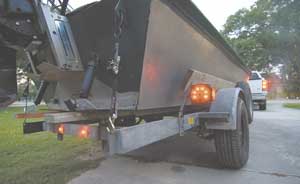
This is the month to throw some topwater plugs in your tackle box, and point your bow to a bay where the reefs are fresh and the trout are hungry.
LED is an abbreviation for light-emitting diodes. They have been around for many years.In the past their use in boats has been more of decoration than function. They have been used as indicator lights to show when a switch is turned on or as an alarm warning such as an overheat indicator light on your dashboard.
LED lights offer many advantages over standard lighting. Technology has greatly broadened the horizons for the use of LED lighting. One new application of this technology is LED lights for boat trailers.
Standard incandescent bulbs emit the full spectrum of light in a spherical pattern. In order to create a color such as red, a filter was installed over that light so that only the desired color would shine through. In some instances the filter would block as much as 90 percent of the bulb’s light energy.
Incandescent bulbs also generate a large amount of heat. This heat shortens the life span of the bulb.
LED lights give off a focused beam of light in a variety of angles, using only one wavelength or color. There is no need for a filter. You simply choose the diode that emits the color you desire. There is no wasted energy, so the LED emits more light from a smaller source and uses less electricity.
The next time you are stuck in traffic, look around at the cars in front of you. Take notice of the third brake light usually in the rear window of the car. You will probably see that the light is much brighter than the standard brake lights.
Most of these third stoplights are LED. Car manufacturers frequently use them because the third brake light is not very easily accessible, which makes changing a bulb almost impossible. The life span of LED lights is measured in years not hours. This makes it the perfect solution for those inaccessible locations.
The real advantage of LED technology for marine applications lies in their basic structural design. Manufacturers start with a semiconductor diode chip, which is mounted in a reflector cup and is connected to electrical wires.
The entire unit is then encased in a solid epoxy lens. This epoxy lens creates a totally waterproof trailer light.
You will no longer have to remember to unplug your trailer lights before backing down at the boat ramp. Your trailer lights will operate at a much cooler temperature, and will not be susceptible to light bulbs breaking when they are submerged in cold water. There will be no more corroded contacts that keep your lights from functioning, and the drivers behind you will see your rig much clearer, and there will be less chance of having your boat rear-ended.
LED lights will cost a little more than the traditional incandescent lights you use now, but the added cost will be returned to you many times over because you won’t have to change so many bulbs or fixtures. The solid-state design makes LED lights shock resistant, vibration resistant, and frequent switching on and off will not harm them. Extreme temperature changes and complete submersion in water will not compromise their long life.
LED lights will usually last more than 100,000 hours. That is equal to more than 11 years of continual use.
The next time you notice one of your trailer lights not working, remember that LED is available, and it is a great alternative to standard incandescent lighting. Check with your local dealer; if he does not stock LED trailer lights, ask him to order them for you. You will be glad you did.
Have a great summer of fun filled boating, and I’ll see you on the water. If you have any questions about your boat, motor or trailer, you can get in touch with me through my web site: www.theboatdr.com, or send an e-mail to hanktheboatdr@yahoo.com.


